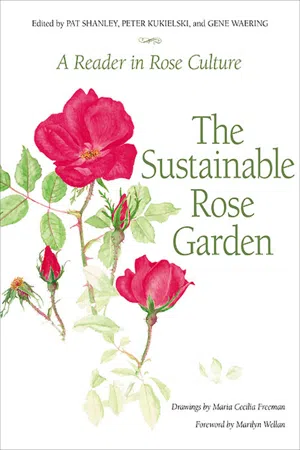
Sustainable Rose Garden
A Reader in Rose Culture
- 288 pages
- English
- ePUB (mobile friendly)
- Available on iOS & Android
About This Book
"A fascinating and informative book for anyone who loves roses but wants to avoid spraying them with toxic chemicals." — The American Gardener A winner of the World Federation of Roses Literary Award, this work brings together experts from around the world to inform gardeners about developments in the new—irresistible yet long overdue—trend toward creating environmentally friendly yet enduring rose gardens, with "sustainability" as the key. The Queen of Flowers, the rose—by Presidential declaration America's National Floral Emblem—was initially left behind as "green consciousness" and the concept of sustainability took hold among the gardening public. But the rose is now making up for lost time. From the workshops of breeders—both in the United States and abroad—a new generation of disease-resistant and low-maintenance rose varieties has emerged in the last decade to fill popular demand. In this book, you will learn how to make your own sustainable rose garden. With 38 lavishly illustrated articles and descriptions of the best new (as well as old) rose varieties designed for the sustainable rose garden, this is a must-have book for today's new generation of avid but environmentally conscious gardeners. "Finally, we have a book that addresses the notion of growing roses in an environmentally friendly manner... Nothing about sustainable rose culture has been presented as well as it has been in this book."—Pacific Horticulture Society
Frequently asked questions
Information
Soil and Water and Roses
DAN MILLS

COMPOSITION OF A GOOD GARDEN SOIL
Table of contents
- Cover Page
- Title Page
- Copyright Page
- Dedication
- Contents
- Drawings
- Flowers
- Foreword
- Introduction
- Growing Tea Roses
- A Close Look at Tea Roses
- Hennessey Revisited: Sustainability, or The Accidental Environmentalist
- Rose Poems by Emily Dickinson
- Historic Disease and Pest Control among Roses
- Rose Studies: Watercolors and Drawings Documenting the Genus Rosa
- Tea and Roses
- Earth-Kind® Rose Trials — Identifying the World’s Strongest, Most Beautiful Landscape Roses
- Charmed by the “Thereness” of My Roses
- Beautiful Foliage, an Important Design Element
- Secret Garden Musk Climber
- Rodents versus Roses
- The Peggy Rockefeller Rose Garden’s Dual Mission of Disease Resistance and Protecting ‘Eva’
- The Roosevelt Island Rose Garden
- Health in David Austin’s English Roses
- Mankind’s Second-Oldest Occupation (Cont’d.)
- The Birth of a Rose Garden
- Soil and Water and Roses
- Notes from the Sacramento Historic Rose Garden
- A Life Filled with Roses
- The Pillar Rose
- Report on Kordes® ADR Roses in the United States, 2010
- Sustainable Gardening Practices at the San Jose Heritage Rose Garden
- Memoirs of a Condo Rose Grower and Composter: Containers for Roses
- Talking about My Work with Roses
- The Days of… Chickens and Roses?
- Garden Valley Ranch Compost Tea Program
- An Accidental Sustainable Rose Garden
- The Historical Significance of ‘Knock Out’®
- Probiotic Rose Growing
- Etiquette of the Rose Rustle
- It’s Only Water!
- Fire Ants versus Molasses
- Sustainable Rose Growing and the Breeding of New Roses: The View from India
- Sustainability Genes: Breeding the Blackspot-Resistant Rose
- A Century (or Two) of Hybrid Musks
- Contributors
- Credits
- Footnote